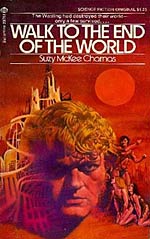
![]() Rhondak101
Rhondak101
5/2/2014
![]()
The book centers on four main characters, three of whom are male, which is something else I found surprising. Yet, each of the four characters is living outside the norms that the community expects for them. Captain Kelmz, Servan d Layo, and Eykar Bek refuse to conform to rigid age roles and/or occupational expectations of this society. And, Alldera, she is trained by the fems to be a messenger and a subversive. By using characters who are all outsiders, Charnas can expose the ways that this hierarchical, rigid community is not working.
Charnas creates a very interesting post-apocalyptic society. Her prologue shows that the world was destroyed by nuclear war. Before the war, the white males began blaming all of the ills of society on the Freaks and the Dirties. The Freaks were the non-heteronormatives, the freethinkers, the communists, etc. And the Dirties were persons of color. The Freaks and the Dirties were slowly eliminated, so when the big nuclear war finally came, there were no scapegoats left, except for the women. But then there's a problem. They need the women for the race to survive, so the men take a few women into the atomic shelters. When the human race emerges after the long nuclear winter, there's a new world order in which women are slaves. The readers do not see the changes happen; instead, we see many years later in a long-established society of bigotry and oppression.
The society is based upon an interesting perversion of Christianity. Charnas describes the basic tenant of the society in this way:
In all the Holdfast, no blood-ties were recognized. All men were brothers—that was the Law of Generations—though some were older brothers and some younger. Thus, men avoided the fated enmity of fathers and sons, who once known to each other must cross each other even to the point of mutual destruction. The sons of the Ancients had risen against their fathers and brought down the world; even God's own Son, in the old story, had earned punishment from his Father. Old and young were natural enemies; everyone knew that (24).
A complex code of behavior develops between the Seniors (the older brothers) and the Juniors (the younger ones). Male children are taken from the Birthing Center immediately and raised in the Boyhouse, where these behaviors and codes of honor are instilled. They are taught how to communicate respectfully with Seniors and how to communicate with their own age group. They are encouraged to form relationships (sexual and otherwise) with men of their own age group. They are also taught that sexual relationships across the age line are forbidden.
Yet, this supposedly stable culture is failing. Its crops are producing less and less each year. There's corruption, and many powerful Seniors ignore laws and codes of behavior, which causes jealousy and resentment among the Juniors. An age war seems imminent. And then there are the four main characters whose lives and whose quest further expose the depth of this society's failure.
While this was not the book I expected, it was a very good one. The society Charnas creates is deep and complex. (I've resisted describing many of the hyper-masculine mores and codes in this review. However, Charnas provides interesting readings of several gendered behaviors.) I believe reading this book will make the sequel, Motherlines, all the more meaningful, which I think is the book that I expected all along. When I finally get to the female society, I will better understand the community that Alldera has left behind and will be able to compare it to the free fem society that she will encounter. I look forward to reading Motherlines and to reading more of Charnas' works.